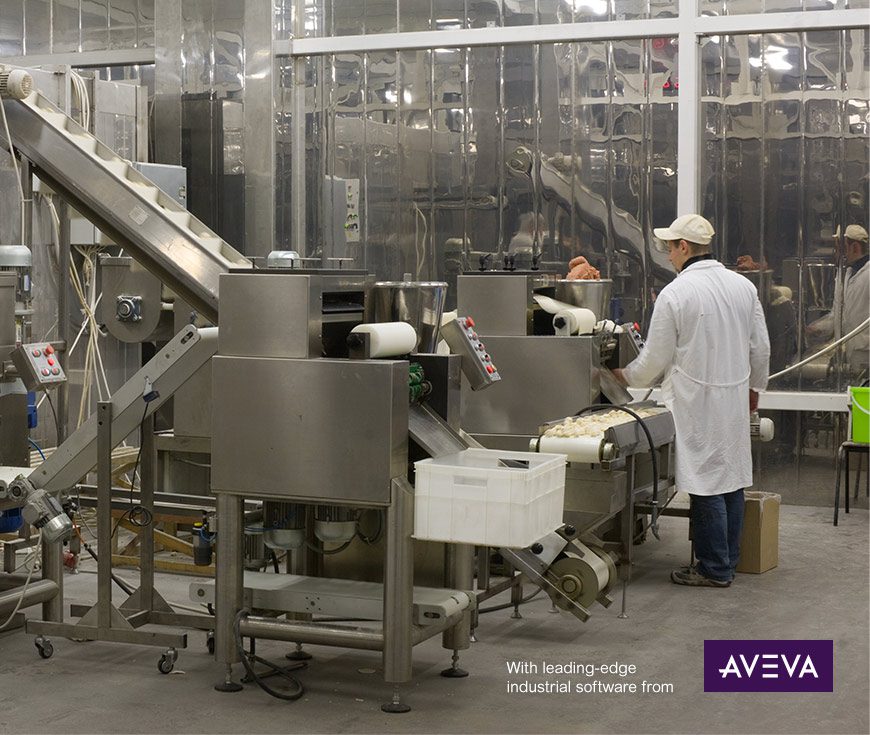 Digitization is reshaping the Food and Beverage business. Given current supply chain disruptions, as well as economic and environmental challenges, companies will remain competitive only by accelerating their digital transformation. In doing so, they can achieve a “net positive impact,” which will enable both supply chains to become more resilient as the company makes more profitable business decisions based on high-quality data.
Digitization is reshaping the Food and Beverage business. Given current supply chain disruptions, as well as economic and environmental challenges, companies will remain competitive only by accelerating their digital transformation. In doing so, they can achieve a “net positive impact,” which will enable both supply chains to become more resilient as the company makes more profitable business decisions based on high-quality data.
Digital acceleration not only tackles efficiency but also resiliency, which includes sustainability programs within an enterprise. It enables companies to efficiently manage their entire supply and value chains, to better interact with their key stakeholders, and to differentiate their brand throughout the process. Such an approach involves the entire ecosystem of the business, and selecting the right technological partners is key.
Technological solutions are here to enable sustainability efficiency and business resiliency, empowering workforce and simplifying operations to master market complexity.
We talked to Keith Chambers, who is responsible for strategic direction, commercialization, and development for AVEVA’s operations management portfolio globally, and Marilidia Clotteau, Food and Beverage marketing Offer Manager at Schneider Electric™.
The Food Revolution

By 2010, the Food & Beverage industry had created 23 of the world’s top 100 brands[1], and had grown total return to shareholders (TRS) almost 15 percent a year for 45 years, based on the following key pillars. These included mass market brand building, distribution relationships with retail grocery, shaping developing marketing, consistent execution and cost reduction, and M&A that increased the benefits of scale. Across that time period, F&B was the second most successful industrial segment.(2)
Prior to 2010, growth and development was mostly about scale, and the ability of the world’s biggest mass market brands to shape developing markets, and to drive and expand their businesses even further, while driving costs down and increasing productivity.
The food revolution in the past ten years, however, changed everything. In many ways, these same five pillars became suspicious. For example, where mass market brand building once was a benefit, now may be viewed with suspicion, with customer attitudes changing in line with market share shifting from Big Food to Little Food.
Now, F&B companies realize there are multiple stakeholders involved: customers, employees, communities in which they operate, and their shareholders, with the definition of “value” being different for each of them. Before COVID, there was a fundamental change of thinking in F&B CPG industry around aligning with the value that these different stakeholders place on the products that they produce.
Then COVID happened, ushering in a new normal. The pandemic added further disruption to supply chains that were already challenged with variety and velocity, amplifying the need for resilience and increased control in manufacturing supply chains[3]. Further complicating the issue, worker safety and social distancing becomes key, along with remote workers who would previously be in-plant, additional shifts, and the need for increased cleaning of equipment. Some products come “in demand,” with companies scrambling to make enough to meet customer needs.
QUOTE: “In the downstream of what’s happening, these changes are persisting, and they’re not going to go away for a while.” (Keith Chambers, 12:00)
Challenges of the New Normal We’re Living In
Digital transformation of the value chain represents an opportunity to reduce costs by 5 – 30% and grow revenue by up to 25%. The previous incremental shift of customer spending for food and beverages in the U.S. has shifted from food services to retail very quickly[4], with $6.5B moving over between March and August 2020, alone. As a result, manufacturing must become more agile and resilient, able to rapidly accommodate changing demand and supply shortages.
Additionally, waste and loss must be minimized, as food waste impacts unit cost and sustainability. For example, in the first two months of lockdown, over 14M liters of milk a day were wasted, corresponding to 1.6M tons of CO2 emissions.[5]
The average cost of a recall is $10M in direct costs, together with additional brand damage and lost sales. The cost of non-conformance is high and can attract regulatory scrutiny and damage reputation with consumers.
Productivity gains in manufacturing have fallen, giving rise to the notion that a strong digital platform across manufacturing operations can unlock new gains.
Four Things to do to Build Resilience and Agility
- Empower employees: Companies need to transform the way work is executed across a team of roles, while enabling collaboration between teams and roles to occur naturally.
- Optimize operations: Manufacturers need to be able to measure and improve process and operations performance, while developing the ability to continuously improve efficiency and adopt change.
- Engage customers: Food and beverage industry members need to comply with safety and regulation, offer farm-to-fork traceability, and introduce new products faster.
- Transform offerings: Businesses need to recognize that offers need to be demand-driven, and supply chains need to support those demand increases as part of the company’s overall resilience, resulting in increased services and new business models.
Three Critical Technologies for Digital Transformation and How to Apply Them
Industry 4.0, a technology approach that has become the de facto standard of companies’ transformation journeys, yields three critical technologies that are worth paying attention to.
The first is the 360 degree Digital Twin: this represents the underlying virtualization or digitalization of your production processes and assets. The digital twin provides the platform at the heart of a new operational architectural proving cloud/edge flexibility, with big data analytics and a mobile/social user experience. It has agnostic connectivity to business systems, data lakes, automation, and IIoT systems. The operations digital twin enables a broad range of solutions for work execution and data capture, across the value chain that provide visibility, guidance, and optimization of production processes.
The second is the Connected Worker: workers are no longer serving the machines; instead, workers are now connected and a part of the system and are fully integrated into the production process. Workers need to be mobile, and mobility brings actionable data and work tasks together at the point where work happens. Collaboration involves sharing knowledge and facilitating working together within the plant or remotely, to improve productivity. Xtended Reality (XR) accelerates the mastery of operations and maintenance tasks for a new generation of workers.
The third aspect connects the first two and is known as Operational Intelligence. This involves taking the tremendous amount of data that comes from the Digital Twin and the Connected Worker, and applying it in ways that we haven’t been able to before, as both predictive and prescriptive analytics. Here, we’re applying machine learning and AI concepts to the process, in an effort to better support the optimization that has to happen within a plant.
Reducing Quality and Food Safety Risks through Traceability
End-to-end traceability is a critical tool to safeguard food safety. End consumers are demanding more information and increased transparencies when it comes to the food and beverage products they buy. Sustainability is also directly linked to end-to-end traceability by World food organizations
“We have been able to see that this new normal push the regulation into more traceability and regulation around it, to bring more food safety to the consumers.” – (Marilidia Clotteau, 32:09).
As perfect examples to illustrate this point, we have been able to see the European Union publishing the “Farm to Fork Strategy” in May 2020 and the Food and Drug Administration (FDA) releasing its “New Traceability Rule Proposal” in September 2020. These are major steps for the Food and Beverage industry!
In the process, a variety of apps have become the new advisors for consumers because they’re seeking a lot of information, and they want to ensure that the products they are buying are safe.
“This is the new reality, asking for traceability. Not only at the plant level, but of our supply chain.” (Marilidia Clotteau, 34:25)
What Is End-to-End Traceability
End-to-end traceability is the ability to identify, collect, and verify siloed data at various stages of the food chain from raw materials to Point of Sales. It involves mapping all suppliers, to collect information such as the origin of the ingredients and to check the certificates of compliance. This is becoming a prerequisite – building traceability and transparency into the entire food system, from the very beginning, and it involves four pillars.
First, what is the scope? A supply chain-wide data collection and storage solution that captures the entire history of finished goods from origin to the point of sale. Data can be accessed anywhere along the supply chain by batch, by date, or where available, by unique identifier.
Next, what are the data sources? This includes master data such as recipe and label data, origin certificates, events, any traceability data from manufacturing such as batch, calibration of devices, cleaning data, unique identifiers at each packaging level, and shipping data among others. Third, who are the users? Consumers, supply chain partners such as transporters and warehouse management stakeholders, regulators, and manufacturers, all being pushed by the end-consumer and the need to go beyond safety.
Finally, key use cases must take into account end-consumers, who are demanding transparency and ethical sourcing; the supply chain, which must be visible and authentic; regulators, who will be in charge of recalls, taxes, and excise; and manufacturers, overseeing food safety investigations, recalls and KPIs, compliance, scorecards, and risk management.
As you can see, end-to-end traceability is mandatory if a company is going to build a credible, sustainable and resilient supply chain, while differentiating their brand from among the competition.
To put it simply, this is the goal: to collect the critical data at different stages of your value chain that starts with the plant. This process also involves integrating data from upstream, including information about the quality of raw materials or certificates of compliance), as well as collecting data downstream from the supply chain, and concentrating or aggregating all of the data into what is known as a data lake. Upon this pool or hub of data, you can begin to build your intelligence.
To build on your end-to-end traceability journey, these are the four main takeaways:
- Plants must be matched with supply chain systems to achieve the agility and resilience needed in today’s “new normal”.
- Changing the way of working and operating rhythms of the plant are no longer optional.
- Operational intelligence provides insights to optimize production, and to support continuous improvement.
- Supply chain traceability improves engagement with customers and safeguards food safety.
For more information on how Schneider Electric can help you start building end-to-end traceability into your business operations, watch the webinar now. (https://go.schneider-electric.com/WW_202101_Food-Beverage-Agility-in-Manufacturing-WebinarLP.html)
[1] https://www.mckinsey.com/industries/consumer-packaged-goods/our-insights/the-new-model-for-consumer-goods
[2] https://www.mckinsey.com/~/media/McKinsey/Industries/Retail/Our Insights/Perspectives on retail and consumer goods Number 7/Perspectives-on-Retail-and-Consumer-Goods_Issue-7.ashx
[3] https://www.bain.com/insights/its-time-to-build-resilience-into-retail-and-consumer-goods-supply-chains/
[4] https://www.fooddive.com/news/coronavirus-forces-manufacturers-to-shift-more-production-to-retail/574618/
[5] https://www.carbonbrief.org/guest-post-coronavirus-food-waste-comes-with-huge-carbon-footprint
[6] https://www3.weforum.org/docs/WEF_Traceability_in_food_value_chains_Digital.pdf



